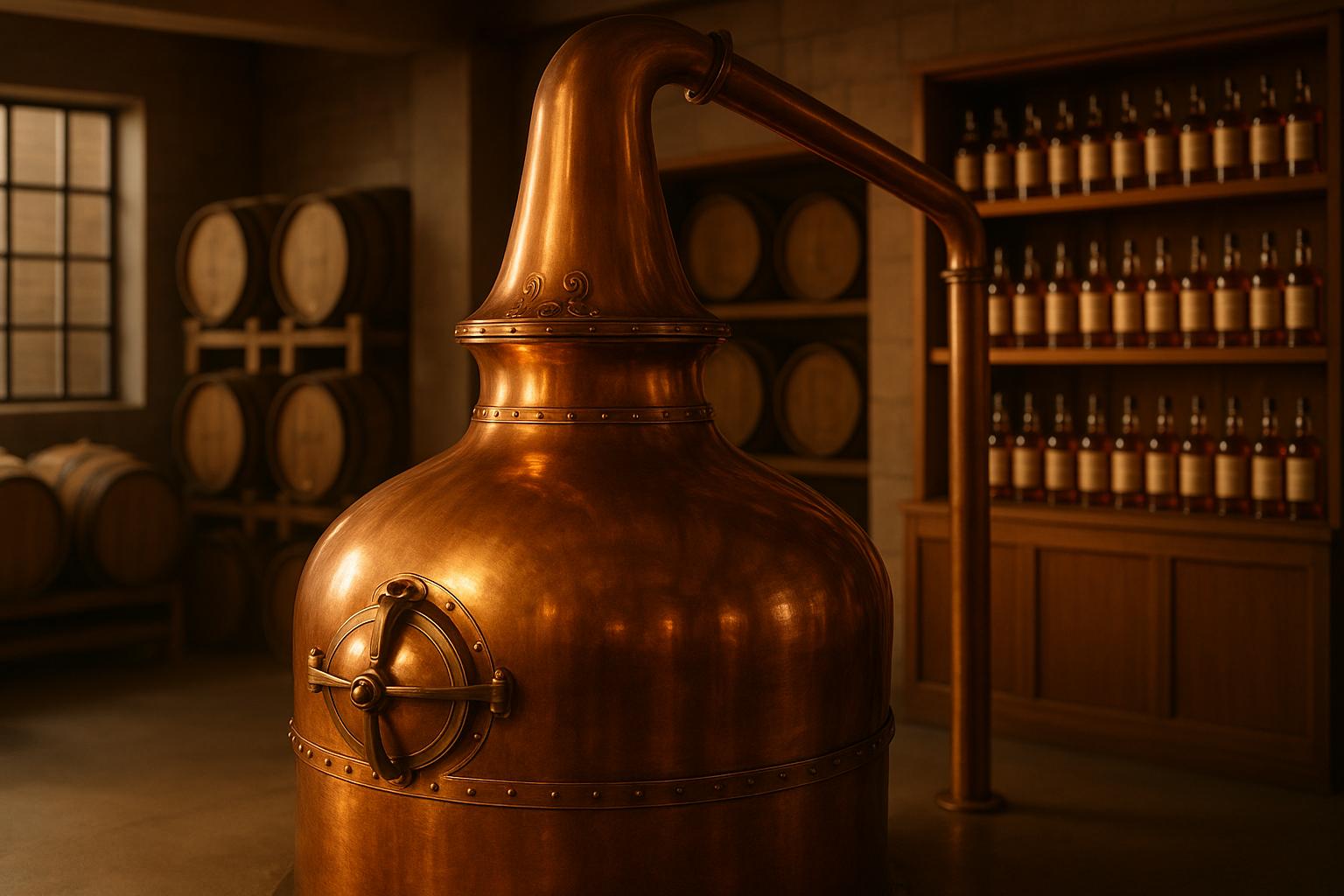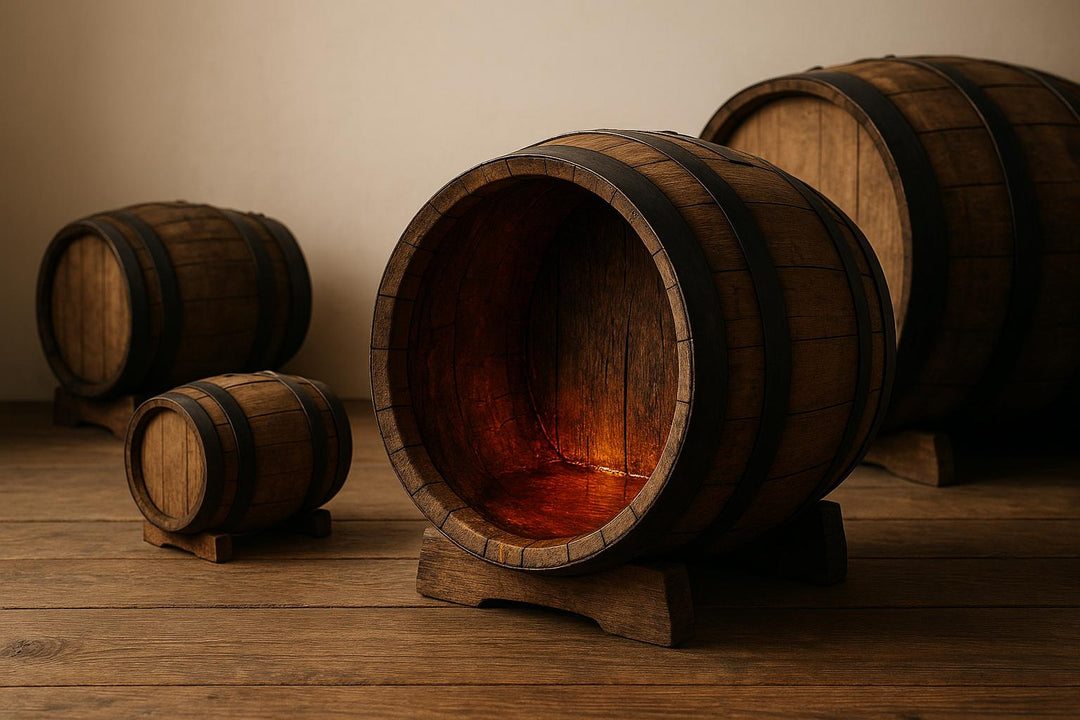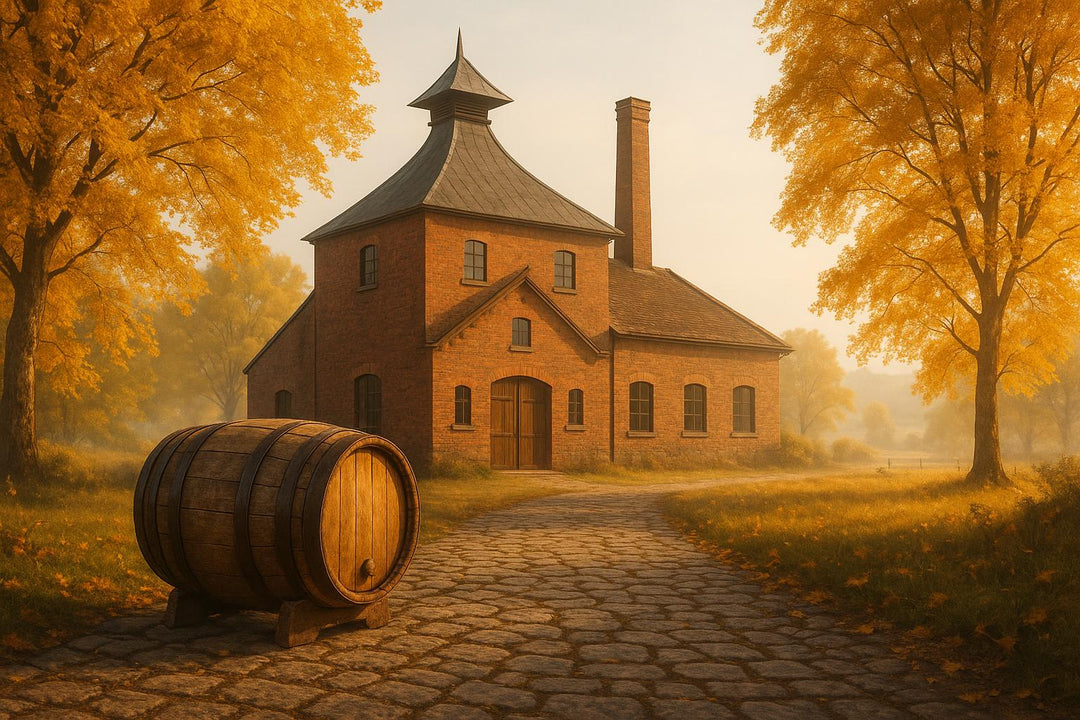Whisky still operations are the core of whisky production, transforming fermented ingredients into the spirit we know as whisky. This process involves heating the wash, collecting alcohol vapours, and condensing them into liquid. Here's what you need to know:
- Distillation Process: Key to defining whisky's flavour and quality. Involves separating "heads", "hearts", and "tails" during heating.
-
Types of Stills:
- Pot Stills: Used for single malt Scotch, offering rich, complex flavours through batch distillation.
- Column Stills: Ideal for grain whisky, providing efficiency and consistency with continuous distillation.
- Copper's Role: Removes unwanted sulphur compounds, refining the whisky's taste.
- Key Equipment: Includes temperature controls, proofing tools, and ventilation systems.
- Techniques: Precise temperature management and cut points are essential for quality.
- Maintenance and Safety: Regular cleaning of copper stills and adherence to safety measures ensure smooth operations.
Understanding these elements helps distillers craft whisky with distinctive profiles while maintaining quality and safety.
How Whisky is made - 3D animation about the production of Whisky (remake 2020)
Equipment for Whisky Still Operations
The tools and machinery used in whisky distillation play a central role in shaping the spirit's character and quality. Each component, from traditional copper pot stills to modern column stills, has a specific function in transforming fermented wash into whisky. Understanding these elements is crucial to appreciating how they influence the final product.
Pot Still Components
Pot stills are iconic in whisky production, especially for single malt Scotch. These copper vessels operate in batches and are designed to create rich, distinctive flavours.
At the heart of the pot still is the pot itself, where the wash is heated. Modern pot stills are crafted from 99.85% pure copper, with 80% of the material being recycled[5]. A new pot still can cost approximately €50,000 (around £44,000)[5]. The size of the still also matters - spirits distilled in pot stills typically reach an alcohol content of 60% to 80% after multiple distillations[4]. For example, the New Midleton Distillery in County Cork, Ireland, operates pot stills with a massive 75,000-litre capacity[4].
The swan neck directs the alcohol vapours upwards, connecting to the lyne arm, which then leads to the condenser. The angle of the lyne arm significantly affects the whisky's character - steeper angles tend to produce lighter spirits, while gentler slopes create fuller-bodied profiles. The condenser, where vapours are cooled back into liquid, also plays a key role in determining the final spirit's quality.
While pot stills are steeped in tradition and known for their character, column stills bring modern efficiency to the table.
Column Stills (Coffey Stills)
Column stills, also referred to as continuous or Coffey stills, are designed for efficiency and consistency. Unlike pot stills, they operate continuously, making them ideal for large-scale grain whisky production.
These tall, cylindrical structures are typically made from stainless steel and divided into sections by vertically stacked plates[3][8]. Each plate serves as a mini-distillation point, allowing for precise separation of alcohol from other compounds. Unlike pot stills, which require emptying and refilling between batches, column stills can run non-stop for several days[3]. This efficiency enables them to produce spirits with an alcohol content as high as 96% ABV, compared to the 60–80% typically achieved by pot stills[8].
"We use column stills mainly for higher throughput production, but we also gain a significant amount of consistency due to the 'cuts' - heads, hearts, and tails - being more automatic compared to a pot still."
– Dr. Pat Heist, Chief Scientific Officer and Co-founder of Wilderness Trail Distillery[3]
Column stills act as precise filtration systems, removing almost everything except ethanol[8]. This results in lighter, cleaner, and more neutral spirits, in contrast to the richer and more complex profiles produced by pot stills[7][8].
Supporting Tools for Still Operations
In addition to the stills themselves, several supporting tools are essential for smooth and consistent whisky production.
- Temperature control systems: These help prevent overheating and ensure the spirit develops properly without burning or acquiring unwanted flavours[10]. Automated controls make it easier to maintain the delicate balance required during distillation.
- Proofing hydrometers and testing equipment: These tools provide accurate alcohol by volume (ABV) readings, ensuring compliance with regulations and maintaining quality standards[10].
- Ventilation systems: Proper ventilation reduces the risks associated with alcohol vapour buildup, creating a safer working environment[10].
Other important equipment includes transfer pumps for moving liquids efficiently, storage tanks for holding wash and spirit, and cleaning systems to maintain hygiene. Industrial sinks, dishwashers, and fire extinguishers are also necessary for safety and cleanliness[9].
The choice of materials also impacts operations. Copper remains the preferred material for 63% of premium spirit producers due to its ability to enhance flavour, while stainless steel is valued for its durability and low maintenance[10]. Many distilleries combine both materials strategically - using copper for areas where flavour interaction is critical and stainless steel for supporting equipment requiring longevity.
Distillation Processes and Techniques
Understanding the art of distillation is key to crafting exceptional whisky. The techniques used during this process directly shape the spirit’s character, strength, and overall quality.
The Distillation Process
Distillation starts with the fermented wash, which typically contains 8–10% alcohol - the starting point for everything that follows [13]. Heating the wash carefully encourages alcohol to evaporate, allowing distillers to separate desirable compounds from unwanted ones, which enhances the flavour of the final product [11][12].
Temperature control plays a crucial role throughout the process. The "hearts" - the most desirable portion - are typically collected when the still’s temperature ranges between 185°F and 200°F (85°C to 93°C) [16]. Maintaining this precision ensures the spirit retains its delicate flavours while avoiding burnt or harsh notes.
The first distillation yields low wines, a liquid with an alcohol content of 20% to 25% [13]. This intermediate product is then distilled again to achieve the desired purity and strength. At this stage, the focus shifts to isolating the essential fraction of the spirit through careful cut management.
Cut Points and Spirit Separation
After distillation, the spirit is divided into three key fractions: foreshots (heads), hearts, and tails (feints). Each plays a unique role in determining the whisky’s quality.
"The precise point at which the cut is made during distilling is, therefore, critical to the character of an individual spirit or brand – and equally lies at the heart of the art (and science) of being a master distiller."
– David Longfield, Decanter's production editor [14]
- Heads: These early vapours contain compounds like methanol and acetone, which are either harmful or unpleasant in taste [16]. Oily and cloudy in appearance, they are separated and discarded to ensure safety and quality [14].
- Hearts: This is the purest and most desired portion of the distillate, rich in ethanol and flavour compounds [16][18]. Typically collected at around 68% alcohol by volume, the heart cut often ranges from 75% to 55% ABV, depending on the desired flavour profile [15][17]. It forms the backbone of a quality whisky.
- Tails: Containing heavier compounds like fusel oils, tails can negatively affect aroma and taste [16][18]. These are also set aside, as their inclusion could compromise the whisky’s character [14].
Distillers rely on their senses - smell, taste, and sight - along with temperature readings and alcohol content to determine the precise timing of cuts [16][17]. Some distilleries even collect fractions in separate containers, allowing for more deliberate decisions later. The timing of these cuts greatly influences the final flavour. For example, whiskies meant for shorter ageing often have tighter cuts for a cleaner taste, while those intended for longer maturation might include small amounts of heads and tails to add complexity [16].
Batch vs Continuous Distillation
The choice between batch and continuous distillation impacts both efficiency and flavour.
- Batch Distillation: Using pot stills, this method operates in stages, allowing for greater control over the process. Though more time-consuming, it produces a full-bodied, complex spirit. Pot stills are particularly suited for crafting premium single malt whisky, as they enable precise cuts and adjustments during each run [20][21].
- Continuous Distillation: This method employs column stills, which run non-stop and are highly efficient. Capable of achieving alcohol concentrations of 92% to 96% ABV [19], continuous distillation creates a lighter, cleaner spirit. It is ideal for grain whisky production, where consistency and scale are key priorities. However, careful management is required to ensure the spirit retains its desired flavour complexity [19].
Each method has its strengths. While pot stills produce richer, meatier whiskies, column stills are better suited for lighter, more neutral profiles. When handled with skill and precision, both techniques can yield exceptional results [20].
sbb-itb-128d6c1
Best Practices for Still Operators
Running a whisky still is no ordinary task - it’s a careful blend of science, craftsmanship, and precision. The best operators don’t just rely on technical know-how; they also develop a sharp sensory awareness and maintain strict safety measures to ensure every batch meets the highest standards.
Skills for Still Operators
A skilled still operator is part scientist, part artisan. They need a solid grasp of the chemistry and biology behind mashing and fermentation, as well as the ability to make precise temperature adjustments. But it doesn’t stop there. Operators must also rely on their senses - especially taste and smell - to determine when to separate the distillate into heads, hearts, and tails. This sensory expertise ensures the spirit’s quality and character shine through.
Mechanical skills are equally important. Knowing how to handle tools and perform minor repairs can prevent small issues from snowballing into major problems. On top of that, juggling multiple batches or managing complex production schedules requires excellent time management. And let’s not forget the importance of staying curious and open to learning - this industry is always evolving, and the best operators grow with it.
Cleaning and Maintenance of Copper Stills
Copper stills are the heart of whisky production, and keeping them in great shape is key to both quality and longevity. Over time, sulphur compounds, tarnish, and mineral deposits can build up, affecting the flavour of the spirit. Regular cleaning prevents this and keeps the equipment running smoothly.
Start by rinsing the still with hot water to clear out any leftover fluids. For tougher buildup, mix hot water with one tablespoon of citric acid per gallon and let it sit for about 30 minutes. Afterward, gently scrub with a soft brush. If the copper needs extra shine, a commercial copper cleaner can help, but abrasive scrubbing or harsh chemicals should be avoided - they can damage the material. Steam cleaning after each run is another effective way to remove lingering odours and flavours, ensuring each batch stays true to its intended profile. Lastly, make sure the still is thoroughly dried before storing it to prevent corrosion and keep it in top condition.
Safety Guidelines and Routine Checks
Safety is a cornerstone of whisky production, and following strict protocols isn’t just about protecting people - it’s also about ensuring the quality of the product. Clean equipment not only improves flavour but also reduces risks like fires caused by residue buildup.
Fire safety is critical. Smoking should be strictly banned in the distillery and barrel house, with clear signs to reinforce the rule. Always keep an eye on operational stills, as unattended equipment increases fire hazards. Proper ventilation is another must - it helps disperse alcohol vapours and other potentially harmful fumes.
To minimise ignition risks, dilute alcohol below its flash point before storing it. Regular inspections of boilers, stills, fermenting tanks, and pumping systems are essential for catching and fixing problems early. Emergency preparedness is just as important. Staff should be trained in fire response, know how to use extinguishers, and be familiar with evacuation routes. Personal protective equipment, like gloves and goggles, can protect operators from burns and chemical exposure. Finally, detailed record-keeping and routine safety audits help maintain a workplace where safety and quality go hand in hand.
Troubleshooting and Quality Control
Even seasoned distillers encounter challenges during whisky production. The key to success lies in identifying problems early and addressing them swiftly. But quality control isn’t just about fixing issues - it’s about having a deep understanding of your process to prevent those problems from occurring in the first place. This aligns with earlier advice on maintaining equipment and ensuring safe operations.
Common Distillation Problems
Distillation issues tend to fall into a few main categories, each with distinct warning signs. Contamination is a frequent culprit, often caused by poorly cleaned equipment or subpar ingredients, which can lead to unpleasant flavours and aromas. Fermentation problems, like stuck fermentation - where yeast fails to convert all the sugars - result in a wash with lower alcohol content than expected. Typically, a normal wash contains 8–10% alcohol by volume (ABV) [22].
Temperature control is another critical factor. Excessive heat can cause rapid boiling and foaming, while insufficient heat results in poor separation and reduced yields. For instance, low wines are expected to reach 20–25% ABV, and readings below this range suggest an issue [22].
Foaming and flooding in distillation columns can also pose significant challenges, often caused by high protein content in the wash or overly aggressive heating. These issues can lead to poor-tasting spirits, inconsistent alcohol levels, and variability in character. After the second distillation, you should aim for roughly 2–5 units of unwanted heads, around 15 units in the hearts, and 5–10 units in the tails for recycling [22]. Major deviations from these figures indicate problems with your distillation cuts.
Troubleshooting Techniques
When problems arise, a methodical approach can save you time and prevent further complications. Start by checking your heat source for any inconsistencies.
"A continuous system requires minimal supervision, runs consistently and predictably, and has a significantly smaller footprint than an equivalent pot still, allowing for more efficient use of resources and space." – Kyle Grant, Project Manager, Vendome Copper & Brassworks [1]
For uneven heating, consider switching to a more stable heat source, such as a band heater or still heater. If using gas, ensure the kettle is shielded from sudden heat fluctuations. Foaming should be addressed immediately to prevent boil-overs. Begin with low heat and gradually increase it; indirect heating methods like steam jackets or water baths distribute heat more evenly. If foaming persists, degas the wash by letting it rest for a day or two before distillation, or filter it to remove solids and proteins. Keep the still filled to no more than 75–80% capacity to allow room for foam expansion, and use food-grade anti-foam agents if necessary.
Low yields often point to leaks or measurement errors. Inspect all joints and seals for leaks, and ensure your thermometer is calibrated and correctly positioned. Avoid distilling until the flask is completely dry, as this can compromise the process. Cooling issues can be resolved by maintaining a steady water temperature and flow rate; using a submersible water pump can help. If you’re working with a reflux still, ensure the column packing isn’t too tight, as this can cause blockages and pressure surges.
Maintaining Whisky Quality Standards
Once operational issues are resolved, maintaining quality requires consistent monitoring throughout production. Pay close attention during distillation as the spirit transitions from heads to hearts and then to tails. The heads often have sharp, acetone-like notes, which gradually give way to the clean, fruity character of the hearts. Heavier, oily aromas signal the start of the tails.
Analytical testing provides objective data to back up sensory evaluations. Regularly measuring alcohol content with hydrometers or other precision tools ensures consistency from batch to batch. Tracking these measurements over time can also help identify trends and potential issues. Detailed records of temperature curves and other process parameters serve as valuable references for future runs.
Preventing contamination is essential. Always use fresh, high-quality ingredients and clean all equipment thoroughly between batches to promote effective fermentation and consistent results. Routine maintenance, such as inspecting seals, cleaning equipment, and checking for blockages or leaks, safeguards both the production process and the final product’s quality.
Documenting each batch’s conditions and any deviations from standard protocols enhances your ability to troubleshoot efficiently and maintain high-quality whisky over time.
Conclusion
As we've delved into the intricate world of equipment, techniques, and troubleshooting, it's clear that the final stages of whisky production demand a blend of precision, skill, and intuition. The art of operating whisky stills brings together machinery, method, and craftsmanship to produce spirits of remarkable quality. From managing temperatures with pinpoint accuracy to mastering the delicate process of making cuts, the journey from wash to whisky is a testament to the distiller's expertise.
Key Takeaways for Whisky Enthusiasts and Distillers
The role of copper in enhancing purity and shaping the spirit's character cannot be overstated. For new distillers, learning to identify the perfect cut points is crucial. This involves monitoring subtle shifts in flavour and aroma while maintaining tight control over temperatures, aided by reliable equipment. The middle cut, typically housing alcohol at 65% to 75% ABV[2], is pivotal in defining the whisky's unique profile.
The choice of equipment plays a significant role in the final product. Taller stills often produce lighter, more delicate spirits, while shorter, broader stills contribute to richer, fuller-bodied expressions. Triple distillation, common in some single malts, results in lighter, fruitier notes, showcasing how operational decisions influence the spirit's identity. Consistency in cut management is vital for maintaining brand integrity, as whisky lovers expect every bottle to deliver the same quality. This reliability is achieved through meticulous monitoring, detailed record-keeping, and an understanding of how variables like heating speed or the angle of the swan neck affect the outcome.
Sustainability is increasingly important in modern distillation. Techniques like using renewable energy and efficient heat exchangers not only reduce environmental impact but also improve operational efficiency. Continuous experimentation and learning ensure that distillers stay at the forefront of their craft.
"The evolution of pot stills is not just a technical progression; it's a cultural and artistic journey that distillers are a part of, carrying forward a legacy that shapes the very essence of the spirits they create." – Everglow Spirits[6]
Every batch is an opportunity to refine techniques and gain a deeper understanding of how even the smallest adjustments can influence the final whisky.
Discover Premium Whiskies with The Really Good Whisky Company

Technical insights into distillation don't just benefit producers - they also deepen the appreciation of whisky lovers. Understanding still operations enhances the experience of every sip, and The Really Good Whisky Company offers a carefully curated selection of premium whiskies that exemplify this craftsmanship. Their collection includes rare and aged expressions that showcase decades of expertise, as well as tasting packs designed to highlight the impact of different distillation methods.
Whether you're drawn to Scotch single malts that reflect the artistry of traditional pot stills, Japanese whiskies known for their precision in cut timing, or American spirits crafted with the efficiency of column stills, their expertly chosen range allows you to explore how technical mastery translates into flavour. With bespoke bottling services, custom labels, and worldwide shipping, The Really Good Whisky Company ensures access to exceptional whiskies, no matter where you are.
For those eager to learn more, comparative tastings offer a fascinating way to explore how variables like still design, heating methods, and cut decisions influence flavour. Their curated selection serves as a gateway to an educational journey, connecting the technical intricacies of distillation with the sensory pleasure of exceptional whisky.
FAQs
What is the difference between pot stills and column stills in whisky making?
Pot stills are the go-to choice for batch distillation, celebrated for creating deeper, more layered flavours. This makes them perfect for crafting single malts. They offer distillers greater control over the whisky's character, though they aren't as efficient as their counterpart, the column still.
Column stills, by contrast, are designed for continuous operation, making them far more efficient for large-scale production. These stills produce lighter, smoother spirits, which are often used in blended or grain whiskies. While pot stills prioritise flavour complexity, column stills excel in delivering consistency and higher output.
How does the angle of a pot still's lyne arm influence the flavour of whisky?
The angle of the lyne arm is a key factor in determining the whisky's character. When the lyne arm slopes upwards, it promotes reflux, where heavier compounds condense and flow back into the still. This process results in a lighter, more delicate, and floral whisky. On the other hand, a downward-sloping lyne arm reduces reflux, allowing heavier compounds to pass through, which creates a whisky with a richer, oilier texture. A straight lyne arm, meanwhile, has little effect on reflux, producing a well-balanced spirit. This small yet significant feature is just one of the many tools distillers use to shape unique whisky profiles.
Why is copper so important in whisky distillation, and how does it enhance the flavour of the spirit?
Copper plays a crucial role in whisky distillation, serving as a natural purifier. It eliminates sulphur compounds that could otherwise introduce harsh, undesirable flavours, resulting in a whisky with a cleaner and smoother profile. On top of that, copper helps create esters - compounds that contribute to the fruity and layered aromas whisky enthusiasts cherish.
But it’s not just about flavour. Copper also enhances the texture of the whisky, lending it a polished and velvety mouthfeel. These qualities make copper an irreplaceable material in the distillation process, ensuring every glass of whisky delivers a rich and satisfying experience.







Leave a comment